Sopwith Triplan
English Translation
.jpg) |
Beaucoup de gens pensent que le triplan est une invention allemande le la 1e Guerre Mondiale avec le Fokker Dr 1. Il convient de corriger cette erreur car le triplan est une invention britannique afin de garder la suprématie aérienne acquise par le Sopwith Camel et qui était en train de se terminer C’est pour cela que ce nouveau type d’avion a été construit
Le Sopwith triplan a un chasseur monoplace conçu et fabriqué par la Compagnie Sopwith Il a rapidement été surnommé le Triplehound ou simplement le triplan.
Il a été construit en petit nombre, Après son arrivée en unités dans la deuxième moitié de 1917 et son utilisation avec le Royal Naval Air Service ou RNAS en tant que chasseur triplan il a continué à servir en tant que avion d’entrainement jusqu'à la fin de la guerre
Développement
D'abord, la société
La société Sopwith a été un brillant météorite dans le monde des constructeurs d’aéronefs Fondée en 1912 fermée en 1919! Sopwith Company a eu une durée de vie très courte
Sopwith Aviation Company a été fondée en 1912 par Thomas Octave Murdoch Sopwith, célèbre pionnier pilote. Elle a été au début de la 1e Guerre une société qui a construit les avions le splus célèbres dans le monde des avions militaires avec le Strutter le Pup et surtout le Sopwith Camel, dont 5.490 ont été construits au cours des deux dernières années de la guerre. Nous trouvons après le triplan Sopwith, le Camel le Dolphin et enfin par le Sopwith Snipe. Le Sopwith Snipe est le dernier avion entré en service au cours des dernières semaines de la 1ère guerre mondiale et est resté en service dans la RAF comme avion de combat dans les années 1920, les Autres produits Sopwith Salamander un avion d attaque au sol et le Cuckoo un bombardier-torpilleur, qui commencent à être livrés en Septembre 1918.
Mais le retour à la paix a été fatal pour Sopwith qui n'’a pas survécu après la fin de la guerre. Les effets de l'après-guerre, avec l'effondrement des commandes d'avions et d'un projet de loi fiscale force Thomas Octave Murdoch Sopwith à fermer l'entreprise en Septembre 1920. Mais Thomas Octave Murdoch Sopwith continue une longue carrière dans l'aviation. Le 15 Novembre 1920, les anciens administrateurs de Sopwith et de leur chef pilote d'essai Harry G. Hawker forment l’ Hawker Engineering Co Ltd, avec comme Président Sopwith. Il restera actif dans l'industrie aéronautique en restant Président de Hawker Siddeley jusqu'en 1963
Reste son heritage d’avions Sopwith Tabloid, 1913 Sopwith Gun Bus, 1914 Sopwith Schneider, 1914 Sopwith Baby, 1914 Sopwith 1 ½ Strutter Sopwith Pub, 1916 Sopwith Triplane, 1916 Sopwith Camel 1916 Sopwith Cuckoo, 1917 Sopwith Dolphin, 1917Sopwith nipe 1918 Sopwith Salamander, 1918
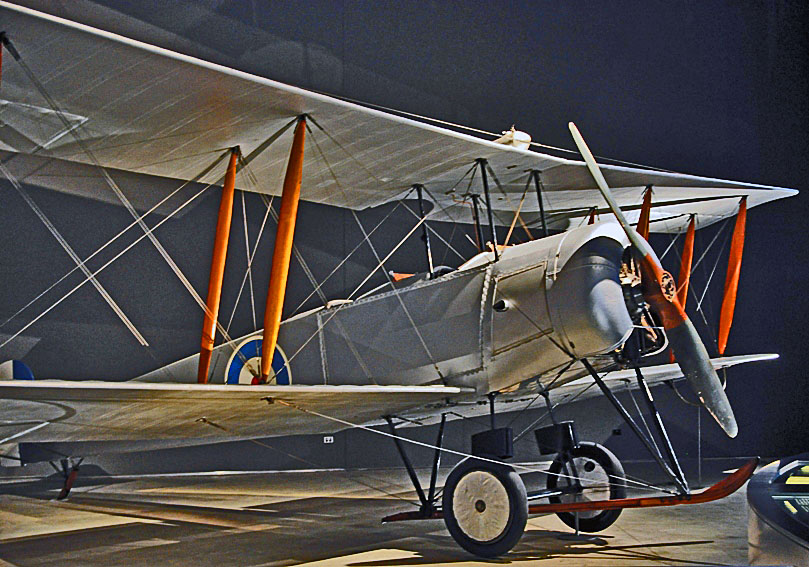 |
| Sopwith Camel |
L'avion
.jpg) |
| Wikipedia |
Le triplan est né d'une initiative privée de l'ingénieur en chef de Sopwith Herbert Smith afin de trouver un successeur au 'Sopwith Pop
Le fuselage et l'empennage d’un Pup, recevra trois ailes étroites afin de fournir au pilote un meilleur champ de vision. Les ailerons sont installés surs toutes les trois ailes.
En utilisant un empennage horizontal mobile, et des stabilisateurs d'incidence (variables)ont peut voler sans les mains et l'introduction d'un stabilisateur de plus petite dimensions (2,43m) en février 1917 a permit d'améliorer le taux de montée
L avion reçoit tout d abord un moteur en étoile 110 ch Clerget 9Z neuf cylindres, mais qui a été remplacé par un 130 ch Clerget 9B en étoile
.jpg) |
| Moteur 130 ch Clerget 9B en étoile |
. Au moins un triplan a été testé avec 110 HP le Rhône en étoile qui, n’apporte pas une amélioration significative des performances.
Le premier vol a lieu avec le prototype N500, le 28e Mai 1916, Le Sopwith triplan est très agile, efficace, sans vices. Lors des manœuvres, toutefois, le triplan présenté une apparence inhabituelle. Certaines personne disent que l'avion semblait être comme un ivrogne montant un escalier
En Juillet 1916, le prototype triplan, série N500, est envoyé à Dunkerque pour l'évaluation auprès du " A" Naval Squadron, 1 Naval Wing. Il s'est avéré très réussi. Un deuxième prototype N504, équipé du moteur 130 ch Clerget 9B de série a également été envoyé à la France pour évaluation Le N504 a effectué son premier vol en août 1916 et a finalement été envoyé en France en Décembre Le triplan, entre peu après en production. 140 avions seront construits
Description
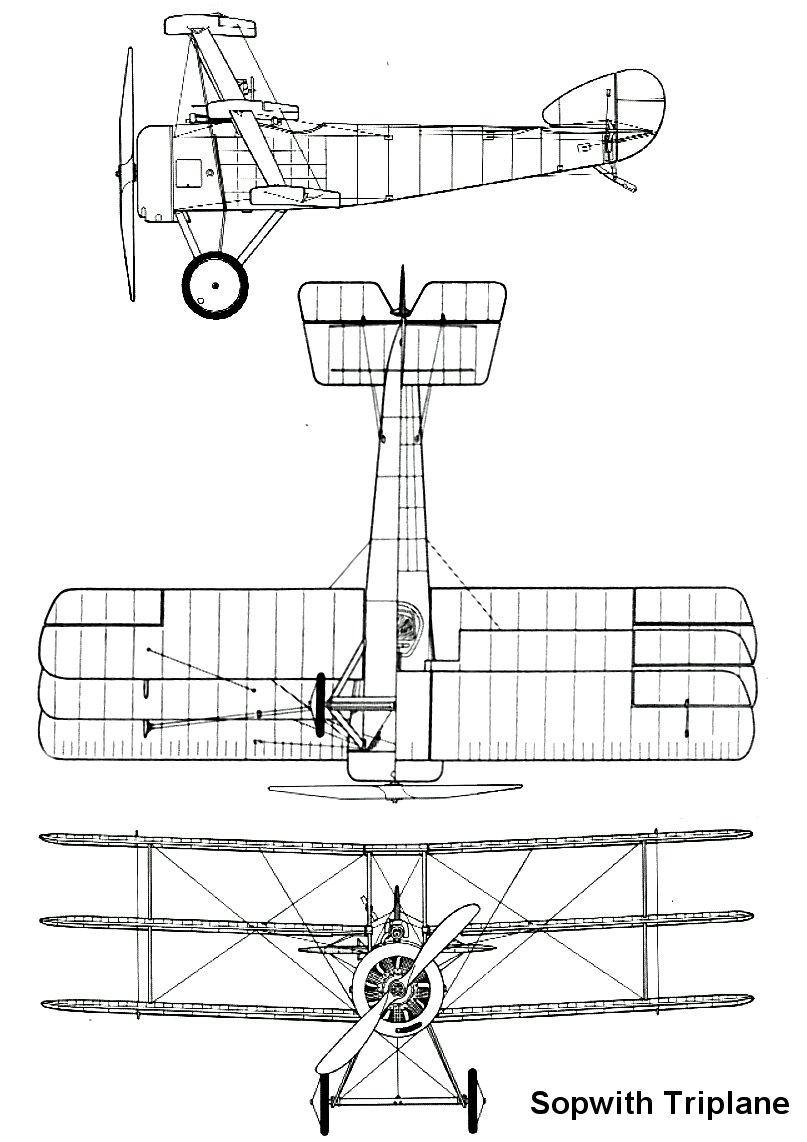 |
| |
Le nouveau chasseur présentait un fuselage très proche du Pup à l'exception de légères modifications nécessaires pour adapter la nouvelle structure de l'aile et un plus grand moteur
Le triplan est un appareil agréable et facile à piloter, avec efficacité, bien des commandes franches. En utilisant les stabilisateurs d'incidence (variables)ont peut voler sans les mains et l'introduction d'un stabilisateur de plus petite dimensions (2,43m) en février 1917 a permit d'améliorer le taux de montée. Alors le triplan grimpe plus vite et est plus agile que ses opposants, mais il est plus lent en piqué .
Le triplan a eu également une réputation de faiblesse structurelle. Les ailes ont parfois été perdues en vol ou lors de manœuvres lors des combats surtout en piqué Ce défaut a été attribuée de mauvais haubans de calibre 47 dans l'avion construit par le sous-traitant Clayton & Shuttleworth, mais cela vient aussi une mauvaise conception de base, En tout cas, les avions rescapés des combat et utilisés comme avions d’entrainement ont été équipés avec des entretoises sur la partie supérieure de l aile
Le pilote est assis juste derrière la grande aile La visibilité, en partie en raison de la structure de l'aile, n'est pas idéale , sous certains angles mais ces défauts sont gommés par les autres qualités de l’avion.
Les performances pour ce triplan sont exceptionnelles, en particulier dans le domaine de la vitesse ascensionnelle réalisée dans un court laps de temps.
Cette conception est très avantageuse surtout dans les combats (dogfighting) et bientôt le Sopwith triplan s’établit une solide réputation dans les deux camps
L'exceptionnelle vitesse ascensionnelle et son plafond lui donne un avantage marqué sur l'Albatros D. III Les Allemands offrent d'une récompense à toute avion qui pourrait égaler ce concept . Anthony Fokker gagnera en développant le Fokker triplan Dr.I Nieuport également expérimenté (sans succès) ce concept de triplan
L'armement des triplan 'se compose d’une Mitrailleuse Vickers MG fixe synchronisée avec le pas de l'hélice
Seuls six avions seront équipés de canons jumellés, mais leur performances s’en ressentent
Le Triplan au combat
.jpg) |
| Le Cirque Volant |
La production a débuté à la fin de 1916. Le Triplan a été affecté exclusivement Royal Naval Air Service hormis quelques exemples fournis à la Grande-Bretagne à ses alliés
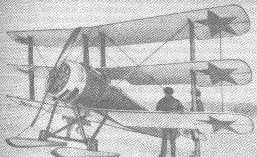 |
| Internet |
Les premiers résultats ont été assez exceptionnels pour justifier une production de masse pour cet type d’avions qui a acquit une aura légendaire et fut un adversaire redouté par les pilotes allemands Le triplan a été affecté au commandée par l’as canadien Raymond Collishaw. L'unité revendiqué 87 avions allemands en trois mois, tous abattus par des triplan. Collishaw lui-même a obtenu 33 victoires avec ce type d 'avion, faisant de lui le meilleur avec cet avion.
A l’origine un lot d'avions était également destiné au Royal Flying Corps (RFC), mais en Février 1917, le RFC reçoit des SPAD VI commandés pour le RNAS.
Pour des raisons inconnues, la commande des triplans le RFC a été tout simplement annulée plutôt que d'être transférée à l'RNAS , et seulement 150 triplans ont été construits
1st Naval Squadron a été pleinement opérationnel avec le triplan en Décembre 1916. Nos. 8, 9 and 10 Naval Squadrons avec le type mi 1917. L’autre utilisateur majeur de ce type d avion sera l’Aéronavale française basée à Dunkerque, qui a reçu 17 appareils.
En Juin 1917 No. 4 Squadron RNAS reçoit son premier Sopwith Camel Bien que les escadrons de Triplan aient aimé leur appareils il était prévu pour eux une conversion sur Camel. Les Nos 8, 9 et 10 Naval Squadrons passeront sur ce nouveau type entre Juillet et Septembre 1917, et la dernière unité a utiliser le triplan, sera le No. 1 Naval Squadron, qui reçoit ses Camel en Décembre 1917 . Cet avion a servi ensuite comme avion d’entraîinement au cours de 1918
.jpg) |
.jpg) |
| Internet |
Internet |
Caractéristiques
Chasseur
Poids à vide 499 kg
Poids brut 698 kg
Equipage 1
Longueur 5,73 m
Hauteur 3.2m
Envergure 8.07m
Moteur
Clerget 9Z, 9 cylindres en étoile, 110 CV
Clerget 9B, en étoile, 130 CV
Le Rhône, 9 cylindres, 110 CV
Vitesse 188 km / h
Autonomie 2 ¾ heures
Plafond 6248 m
Armement 1 303 mitrailleuse Vickers synchronisée
Utilisateurs Users
.png) |
.png) |
.jpg) |
| Royaume Uni |
France |
Russie |
Voir Aussi See also
Fokker Dr1 I
Sopwith Triplane
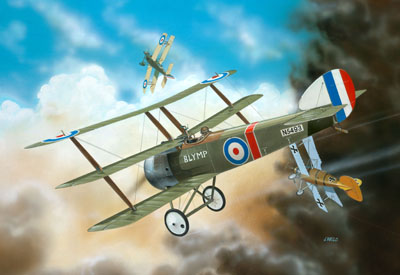 |
Many people think that the Triplane during WW1was a German invention with the Fokker Dr 1 . It is no correct because the Triplane was a British invention to keep the air control when the supremacy of Sopwith Camel ended . So a new aircraft was built
The Sopwith Triplane was a single seat fighter designed and manufactured by the Soppwith Aviation Company He was quickly nicknamed the Triplehound or simply the Tripe.
He was built in comparatively small numbers, but after his arrival in unities in the latter half of 1917 and this use with Royal Naval Air Service or RNAS Triplane continued to serve as a trainer until the end of the war
Development
First the company
The sopwith was a shining meteorite in the wolrd of aircraft builders Founded 1912 closed in 1919!!! Sopwith Company had been short-lived
Sopwith Aviation Company was founded in 1912 by Thomas Octave Murdoch Sopwith, noted pioneer pilot. She was at the start of WW 1 a company with major success in the world of military aircraft with the Strutter the Pup and mostly the Sopwith Camel, of which 5,490 were built in the last two years of the war. Whe found after Sopwith Triplane the Camel the Dolphin and finally by the Sopwith Snipe. The Sopwith Snipe was the last aircraft entered service in the last few weeks of the WW1 and remained the standard RAF fighter aircraft in the 1920’s Other products the Sopwith Salamander a ground-attack aircraft and the Cuckoo, a purpose built torpedo-bomber which began to be delivered in September 1918.
But the return to peace was fatal for Sopwith who did not survive after the end of the war. A combination of the post-war collapse in aircraft orders and a massive tax bill forced Thomas to close down the company in September 1920. But the manager Sopwith himself had a long career in aviation. On November 15th 1920, the former directors of Sopwith and their chief test pilot Harry G. Hawker formed the Hawker Engineering Co Ltd, with Sopwith as Chairman., remaining Chairman of Hawker Siddeley until 1963
follow the list of the major aircraft built by Sopwith Sopwith Tabloid, 1913 Sopwith Gun Bus, 1914 Sopwith Schneider, 1914 Sopwith Baby, 1914 Sopwith 1 ½ Strutter Sopwith Pub, 1916 Sopwith Triplane, 1916 Sopwith Camel 1916 Sopwith Cuckoo, 1917 Sopwith Dolphin, 1917Sopwith nipe 1918 Sopwith Salamander, 1918
.jpg) |
| Sopwith Camel |
The Aircraft
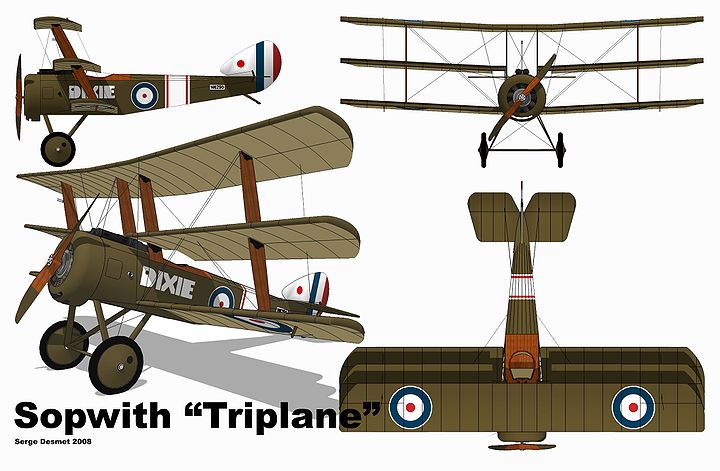 |
| Wikipedia |
The Triplane was born as a private venture under the management of chief engineer of Sopwith Herbert Smith to found a successor to the Sopwith Pop
Fuselage and empennage is the one of the Pup, but he receive three narrow-chord wings to provide the pilot with an improved field of view. Ailerons were fitted to all three wings. By using the variable incidence tailplanes, the aircraft could be trimmed to fly hands-off. The introduction of a smaller 2.43 meter span tailplane in February 1917 improved elevator response
.jpg) |
| Internet |
First Triplane receive a 110 hp Rotary engine Clerget 9Z nine-cylinder but he was remplaced after by a the 130 hp Clerget 9B rotary. At least one Triplane was tested with a rotary 110 HP le Rhône who did not provide a significant improvement in performance.
.jpg) |
| 130 hp Clerget 9B rotary |
First filgth with the prototype serial N500, took place on May 28th 1916, Sopwith Triplane was very agile, with effective, well-harmonised controls. When maneuvering, however, the Triplane presented an unusual appearance. Some person said that the aircraft looked like "a drunken flight of steps" when rolling. In July 1916, the prototype Triplane, serial N500, was sent to Dunkirk for evaluation with "A" Naval Squadron, 1 Naval Wing. It proved highly successful. A second prototype fitted with a 130 hp Clerget 9B, serial N504, was also sent to France for evaluation N504 first flew in August 1916 and was eventually sent to France in December The Triplane, was only limited in production to just 140 units
Description
.jpg) |
| Internet |
The new fighter featured a fuselage very closely following the design of the Pup's, apart from minor changes needed to fit the new wing structure and a larger motor
The Triplane was a pleasant and easy aircraft to fly, with effective, well-harmonised controls. By using the variable incidence tailplane the fighter could be trimmed to fly hands-off. The introduction of the new eight-foot span tailplane in February 1917 improved elevator response. While the Triplane climbed faster and was more agile than its opponents, it was slower in a dive.
The Triplane also gained a reputation for structural weakness. The wings were prone to lose their alignment ("get out of true") after combat manoeuvrers, and sometimes even collapsed in flight, especially under the strain of steep dives. This defect has been attributed to the use of light gauge bracing wires in the 47 aircraft built by subcontractor Clayton & Shuttleworth, although it may also have been the fault of the basic design, which used very few bracing wires. In any case, the fairly small number of surviving aircraft that were used as advanced trainers after the end of the triplane's operational career were fitted with additional bracing to the upper centre section. The pilot sat just behind the large three-wing assembly in a box-type fuselage. Visibility, in part due to the wing structure, was not ideal at some angles though the aircraft made up for this deficiency in other more potent ways.
Performance for the three-wing aircraft was exceptional, particularly in achieving altitude in a short amount of time. The design allowed for maximum lift that became highly advantageous in dogfighting and soon earned the Sopwith Triplane a solid reputation on both sides .The exceptional rate of climb and high service ceiling of the Triplane gave it a marked advantage over the Albatros D.III Germans offered up a reward to any aircraft maker that could equal the design. Anthony Fokker would end up taking the call with the development of the Fokker Dr.I Triplane series. Nieuport also experimented (unsuccessfully) triplane designs
The armament of the Triplane' was light with a single fixed synchronized two-bladed propeller system.
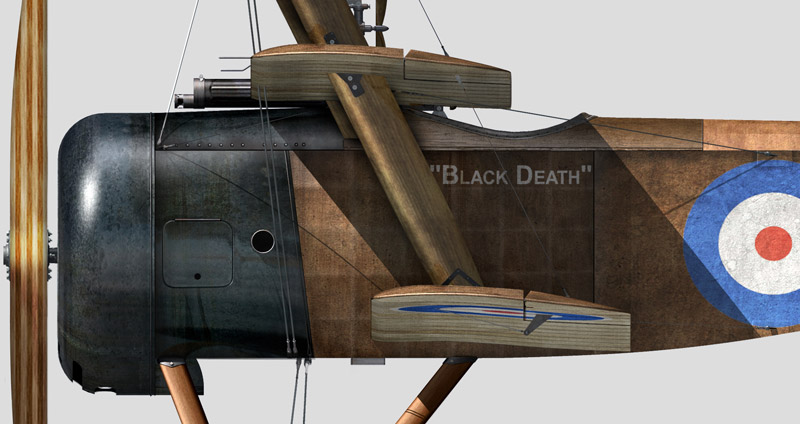 |
.jpg) |
| Internet |
Vickers machine gun. Only six aircraft were fitted with twin guns, but performance was reduced, and the single gun remained standard
Operational Life
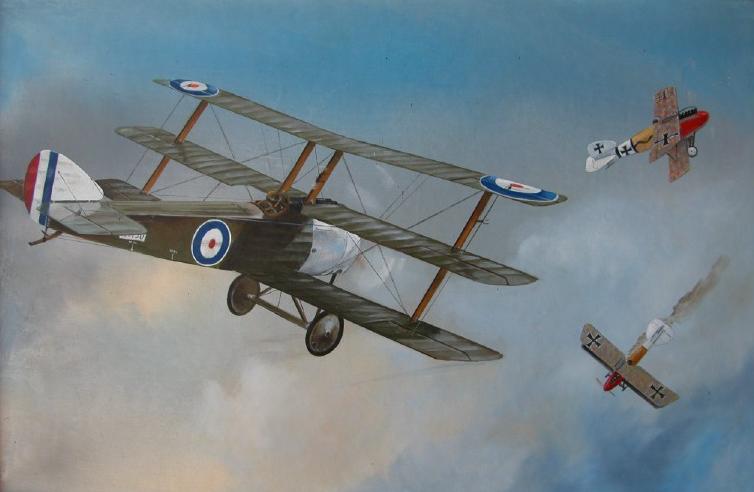 |
| Flying Circus |
Production commenced in late 1916. Triplane was flown exclusively by the Royal Naval Air Service apart few examples supplied to Great Britain's allies Initial results were outstanding enough to warrant full production status for the well-performing aircraft
.jpg) |
| Internet |
This type of success garnered the Sopwith Triplane legendary status and thus was a highly-feared adversary to German pilots.Triplane was famously flown by the "Black Flight" (of No. 10 Naval Squadron) which was commanded by the Canadian ace Raymond Collishaw. The unit claimed 87 German aircraft in three months while equipped with the Triplane. Collishaw himself scored 33 victories in the aircraft, making him the top scorer with the type.
Originally a batch of aircraft were also destined for the Royal Flying Corps (RFC) but in February 1917, the RFC orders were exchanged for the SPAD VIIs on order for the RNAS.
For unknown reasons, most of the Triplanes ordered for the RFC were simply cancelled, rather than being transferred to the RNAS, and only 150 or so were built.
1st Naval Squadron was fully operational with the Triplane by December 1916. Nos. 8, 9 and 10 Naval Squadrons were equipped with the type by the middle of 1917. The only other major operator of the Triplane was a French Aviation Maritime squadron based at Dunkirk, which received 17 aircraft. In June 1917, No. 4 Squadron RNAS received the first Sopwith Camels and the advantages of the sturdier, better armed fighter quickly became evident. Although the Triplane squadrons were still doing well, they were all slated for early conversion to Camels – Nos. 8, 9 and 10 Naval Squadrons converted to the new type between July and September 1917, and the last unit to operate the Triplane, No. 1 Naval Squadron, received its Camels in December. This aircraft served after as a conversion trainer for several squadrons during 1918
.jpg) |
.jpg) |
| Internet |
Internet |
Technical data
Figther
Empty weigth 499 kgs
Gross Weigth 698 kgs
Crew 1
Length 5.73 m
Heigth 3.2m
Wing Span 8.07m
Engine
Clerget 9Z, 9 cylinder, rotary, 110 hp
Clerget 9B, rotary, 130 hp]
Le Rhône, 9 cylinder, 110 hp
Speed 188 km/h
Range 2¾ hours
Ceiling 6,248 m
Armement 1 synchronized Vickers .303 machine gun






.jpg)

.jpg)
.jpg)
.jpg)

.jpg)

.jpg)

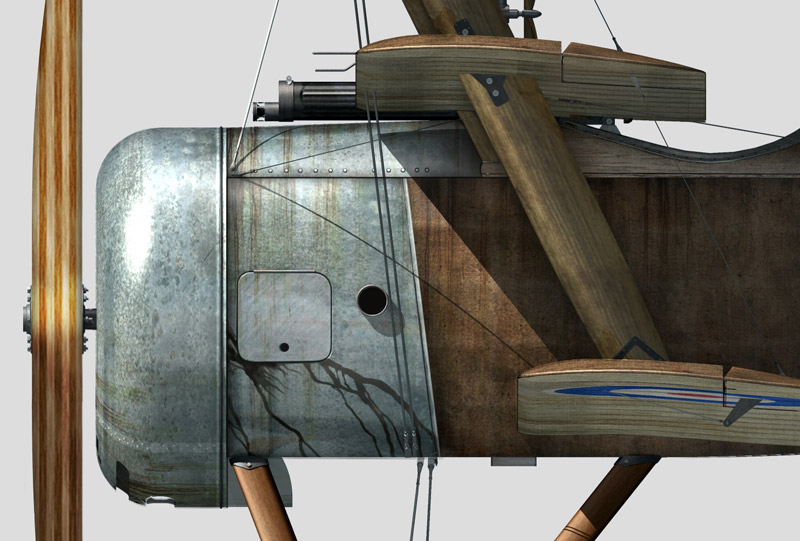
.jpg)
.jpg)

.jpg)
.jpg)

.png)
.png)
.jpg)
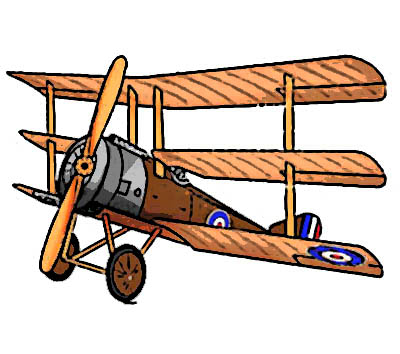

.jpg)

.jpg)
.jpg)
.jpg)
.jpg)
.jpg)
.jpg)
.jpg)

.jpg)

.jpg)
.jpg)
.jpg)